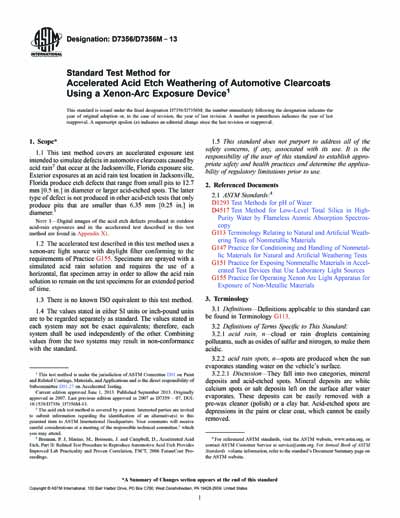Historical
ASTM D7356/D7356M-13
Standard Test Method for Accelerated Acid Etch Weathering of Automotive Clearcoats Using a Xenon-Arc Exposure Device
1.1 This test method covers an accelerated exposure test intended to simulate defects in automotive clearcoats caused by acid rain2 that occur at the Jacksonville, Florida exposure site. Exterior exposures at an acid rain test location in Jacksonville, Florida produce etch defects that range from small pits to 12.7 mm [0.5 in.] in diameter or larger acid-etched spots. The latter type of defect is not produced in other acid-etch tests that only produce pits that are smaller than 6.35 mm [0.25 in.] in diameter.3
1.2 The accelerated test described in this test method uses a xenon-arc light source with daylight filter conforming to the requirements of Practice G155. Specimens are sprayed with a simulated acid rain solution and requires the use of a horizontal, flat specimen array in order to allow the acid rain solution to remain on the test specimens for an extended period of time.
1.3 There is no known ISO equivalent to this test method.
1.4 The values stated in either SI units or inch-pound units are to be regarded separately as standard. The values stated in each system may not be exact equivalents; therefore, each system shall be used independently of the other. Combining values from the two systems may result in non-conformance with the standard.
1.5 This standard does not purport to address all of the safety concerns, if any, associated with its use. It is the responsibility of the user of this standard to establish appropriate safety and health practices and determine the applicability of regulatory limitations prior to use.
ASTM International [astm]

